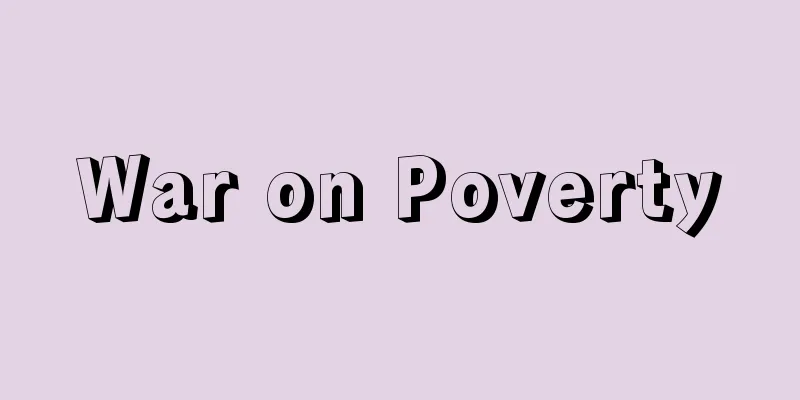Rwanda (English spelling) Republic of Rwanda

|
Located in central Africa, it is a small landlocked country bordering Uganda, Tanzania, Burundi, and the Democratic Republic of the Congo (formerly Zaire). Its official name is the Republic of Rwanda (Repubulika y'u Rwanda), and during the colonial period it was called Ruanda. It has an area of 26,338 square kilometers and a population of 10.72 million (estimated in 2011). Its population density is 407 people per square kilometer, one of the highest in Africa. Its capital is Kigali, and its population is approximately 1 million (2006). It is a member of the Commonwealth of Nations. [Ken Akasaka and Yukiko Kondo] Nature and GeographyKnown as the "country of a thousand hills and a thousand lakes," most of the country is made up of plateaus at around 1,500 meters above sea level, with valleys and wetlands scattered throughout, gently eroded by the small rivers of the upper reaches of the Nile. Mountains over 2,000 meters above sea level run through the southwest, and further west they drop into the Great Rift Valley, forming Lake Kivu and the Ruziji River. In the north, the Virunga volcanoes erupt, forming a chain of mountains between 3,000 and 4,000 meters above sea level, including Mount Karisimbi at 4,507 meters and Mount Muhabura at 4,127 meters. The Virunga volcanoes are also home to mountain gorillas. The eastern region on the border with Tanzania is a savanna plain 1,000 meters above sea level, with lakes and wetlands spreading across it. It is rich in fauna, including carnivores such as lions, leopards, and crocodiles, large mammals such as zebras, antelopes, elephants, giraffes, buffaloes, and hippos, as well as birds such as crowned cranes and pelicans, and has long been known as Akagera National Park. The climate is cool because the country is made up of plateaus, and the average annual temperature in Kigali (1,492 meters above sea level) is only 20°C. Annual precipitation is less than 1,000 mm in the eastern part of the country, which is the cause of the savanna vegetation. In the central region, despite the precipitation of around 1,500 mm, the mountainous landscape is dominated by tropical forests. Montane forests have developed in the high mountains of the western part of the country, at an altitude of 3,000 to 4,000 meters. The capital, Kigali, is located in the center of the country, and is equipped with an international airport. Urban development is underway, including the construction of hotels with modern facilities. Butare in the south was the administrative center during the colonial period and is now home to a university. Other major cities include Ruhengeri in the north and Gisenyi on the shores of Lake Kivu. Road construction connecting these cities is also progressing rapidly. [Ken Akasaka and Yukiko Kondo] historyThe indigenous people are the Twa people, and although they are a minority today, they live a hunter-gatherer lifestyle. The traditional theory is that "Bantu-based agricultural Hutu people began to live in the area around 1000 AD, and then Nilotic Tutsis invaded from the north with cattle in the 15th century. The two groups are different in physique, and the tall pastoral Tutsis (just over 10% of the population), although they were a minority, subordinated and dominated the majority Hutus (just over 80% of the population) in a feudal relationship of master and servant, and formed a kingdom with a king called Mwami." However, this theory has been questioned in recent years. Both Tutsis and Hutus speak Bantu languages. Due to the difference in their occupations, the Tutsis are classified as an ethnic group that focuses on pastoralism, while the Hutus are classified as an ethnic group that focuses on agriculture, but the two groups have been intermingling while being in conflict with each other. It was the colonial policies of European countries since the 19th century that clearly distinguished the Tutsis and the Hutus and deepened their conflict. Colonial authorities in the early 20th century indirectly strengthened their rule by forcing residents to state their Tutsi, Hutu, or Twa origins on their identity cards, thereby creating disparities in treatment. Germany came to power in the 1890s, and the area was colonized as Ruanda-Urundi, together with neighboring Burundi (called Urundi during the colonial period), as part of German East Africa from 1899 to 1916. After World War I, it was a League of Nations Mandate territory, and after World War II, it was a United Nations Trust Territory, together with Zaire (now the Democratic Republic of the Congo), under Belgian colonial rule. Under Belgium's policy of indirect rule, the traditional Tutsi kingdoms continued to exist strongly, and the power of kings and chiefs was preserved. Tutsi enjoyed power under the colonial system, and also monopolized education run by the Catholic Church. On the other hand, the majority of Hutus were unable to access these things, and their discontent grew. In 1957, Hutu intellectuals issued the "Manifeste des Bahutu," which declared the end of Tutsi tyranny and the overthrow of the colonial system, and political activities began, centering on its members. In 1959, the death of King Mutara III (1912-1959) led to a deterioration in relations between the Belgian authorities and royalists made up of Tutsi intellectuals. On the All Saints' Day holiday in November of the same year, the Hutus finally rose up, and the unrest that began in the central region spread throughout the country. With the backing of the Belgian authorities, the decision was made in 1961 to abdicate the newly crowned King Kigeli V Ndahindurwa (1935- ) and abolish the monarchy. In October of the same year, Gregoire Kayibanda, leader of the Hutu Liberation Movement Party (PARMEHUTU: Parti du mouvement de l'émancipation hutu), which was formed mainly in the Gitarama region in the central part of the country and in the north, won nearly 80% of the votes in parliament and became the first president of Rwanda under UN supervision. On July 1, 1962, the Republic of Rwanda was born. [Ken Akasaka and Yukiko Kondo] PoliticsBetween 1961 and 1966, guerrillas, mainly Tutsis who had fled to neighboring countries, attempted to invade Rwanda many times, but each time thousands of Tutsis were massacred in retaliation. By May 1964, the number of Rwandan refugees who had fled to neighboring countries had reached 150,000. During the Kayibanda regime, violence against Tutsis was practically officially recognized, and Tutsis were excluded from the political stage. Furthermore, the influx of refugees and guerilla invasions caused political instability and deterioration of relations with neighboring countries, including Burundi. The 1972 genocide of Hutus in Burundi once again strained relations between the two countries, and it is said that anti-Tutsi sentiment was revived within Rwanda. Driven by this political instability and resentment against the hegemony of the center, General Juvénal Habyarimana (1939-1994) from the north staged a military coup on July 5, 1973. PARMEHUTU was dissolved, and the Revolutionary Movement for National Development (Mouvement révolutionnaire national pour le développement) was formed in 1975. The 1978 constitution transformed the MRND into a one-party state. President Habyarimana advocated development based on agriculture, and adopted policies that advocated national reconciliation by introducing quotas on the number of people in the power structure based on region and ethnic group. However, the serious economic downturn and stagnation of agricultural production since the 1980s, as well as the deterioration of the living conditions of urban residents due to the introduction of the structural adjustment policy, shook the legitimacy (political foundation) of the Habyarimana regime. In 1990, the Rwandan Patriotic Front (Front Patriotique Rwandais), an anti-government armed group formed by Tutsi refugees who had fled to neighboring Uganda, crossed the border and invaded the northern region, sparking a civil war. In August 1993, a peace agreement (the Arusha Accords) was signed in Arusha, neighboring Tanzania, but in April 1994, the presidential plane was shot down and President Habyarimana was killed, triggering a massacre of Tutsis and moderate Hutus, mainly led by Hutu extremist militias. In response, the FPR launched a major offensive, seizing control of the mainland in July and establishing a new government, with Pasteur Bizimungu (1950- ) of the FPR becoming president. The massacres, which took place in just under 100 days from April 1994, claimed the lives of over 500,000 people. Hutus fled to neighboring countries such as Zaire (now the Democratic Republic of the Congo) as refugees. The United Nations High Commissioner for Refugees (UNHCR) and NGOs (non-governmental organizations) from various countries provided assistance to refugee camps in eastern Zaire. The number of refugees who fled is said to be as high as 2 million, but they began to return home in 1996. When President Bizimungu resigned in March 2000, Vice President Paul Kagame (1957- ) became interim president. Kagame won the first presidential election since the 1994 genocide in August 2003 with 95% of the votes, becoming the official president. He was re-elected in the August 2010 presidential election with over 90% of the votes. Kagame has promoted policies of national harmony and reconciliation, including the abolition of identity cards listing ethnic groups and reform of the inheritance system. In November 1994, the International Criminal Tribunal for Rwanda (ICTR) was established in Arusha, Tanzania. In the 2000s, a local-level judicial system called "Gacaca" was implemented as a complementary system to the ICTR and domestic courts to try the huge number of genocide perpetrators, and by the end of 2010, more than 400,000 murder cases had been tried. A new constitution was enacted in 2003, and the Genocide Ideology Law was enacted in 2008. Meanwhile, a UN report released in October 2010 reported that the FPR was involved in numerous massacres of refugees, including civilians, who fled to Zaire in July 1994, raising suspicions of serious human rights violations by the FPR. The political system is a republic. The term of office of the president is seven years, and a third term is prohibited. The parliament is a bicameral system with 26 seats in the upper house (8-year term) and 80 seats in the lower house (5-year term). The constitution stipulates that the number of female representatives must exceed 30%. [Ken Akasaka and Yukiko Kondo] economyApproximately 80% of the population is engaged in agriculture, and most of the land is cultivated. Agricultural productivity has been steadily increasing year by year, and as of 2011, the country was self-sufficient in 90% of its food consumption. The main self-sufficiency crops are beans, sorghum, sweet potatoes, potatoes, cassava, bananas, and corn. The main cash crops are tea and coffee, which account for more than 90% of the cash crop export value. In 2010, the export value of tea reached 55.7 million dollars. Livestock farming is popular, and in 1992, 610,000 cattle, 1.1 million goats, 390,000 sheep, and 1.42 million pigs were raised, but it is said that 80% of the cattle and 90% of the small livestock were slaughtered during the conflict. As of 2011, 820,000 cattle and 1.4 million small livestock were raised. As for mineral products, tin is produced north of Kigali and is a major export item. Tungsten ore is also produced, but on a small scale. Natural gas also erupts around Lake Kivu. Hydroelectric power is generated in several locations, the largest of which is the Mururu Power Station on the Ruzizi River. However, in recent years, due to the drop in water levels in rivers and lakes, thermal power generation accounts for 60% of electricity production. Meanwhile, investment is being promoted in solar power, geothermal energy, and methane gas as alternatives to forest resources such as firewood, which account for 80% of energy consumption. Industry is generally sluggish, but light industries such as soap, paint, insect repellent, and rubber shoes are concentrated in Kigali. A beer factory is located in Gisenyi. Rwanda's gross domestic product (GDP) is $5.6 billion (2010), and its per capita GDP is $540 (2010). Despite the global recession, the GDP growth rate was 7.6% (2010), higher than other African countries. Rwanda generally suffers from the same problems as other landlocked countries, and is about 1,200 km from Mombasa, Kenya, the eastern exit, and from May to August 1976, Uganda closed that route, putting the country in a difficult position. In addition to its poor geographical location, the country has underdeveloped industries other than agriculture, and in its long-term development plan (VISION 2020) it is working to transform its economy from one dependent on agriculture to one based on knowledge. Taking advantage of the mountain gorillas in Volcanoes National Park and its many other excellent natural resources, the country is also focusing on the tourism industry. In 2008, the country welcomed 980,000 foreign visitors. In 2007, the country joined the East African Community (EAC), and a common market was established in July 2010. The currency used is the Rwandan franc. [Ken Akasaka and Yukiko Kondo] Society and CultureThe majority of the population is made up of Bantu Hutu farmers, but it is said that in the past a small number of Tutsi pastoralists formed the ruling class and formed a kingdom with a centralized organization. The kingdom was divided into about 40 local organizations, each with a land chief who managed the collection of taxes on agricultural produce and a pastoral chief who collected taxes on livestock products. In the center of the kingdom, most of these chiefs were Tutsi, and Tutsi also formed warrior bands. The region was further divided into administrative districts based on the countless hills scattered around. Most of the hill chiefs were Tutsi, but Hutus could also take office. The hill chiefs served the land chiefs and pastoral chiefs and acted as intermediaries for the payment of tribute. By acquiring rights to the land, the kingdom strengthened its control over the Hutus living there. The Tutsis held monopoly on the ownership of cattle, which were central to the value system, and Hutus gained the opportunity to own and raise cattle through compulsory service to the Tutsis, such as supplying them with agricultural crops and providing labor. The complex religious ideas of the Rwandan people surrounding the "life force" were described in detail in "The Earth Philosophy of the Bantu Rwandans" by Rwandan philosopher Alexis Kagame (1912-1981), which promoted research into traditional African religions. The material culture of the country is also sophisticated, with geometrically patterned woven baskets, straw mats, and unglazed pots being particularly well-known. Traditional music accompanied by string instruments also has a unique sound. Today, Christianity is widespread, with cardinals being produced. In 1991, before the genocide (1994), 62% of the population was Catholic, but in 2001, after the conflict, this figure had fallen to 56.5%. Other Christians are estimated to be Protestants (26%), Seventh-Day Adventists (11%), Islam (4.6%), and other traditional religions. Education is widespread, with over 790,000 students attending primary school in 1985. There are also many universities, with the National University of Butare in the south opening in 1963 and 1,577 students attending in 1984. French is the official language along with Nyarwanda (Kinyarwanda), but due to the country's accession to the East African Community and the deterioration of relations with France, English was added as an official language in 2008, and school education is also conducted in English. Swahili is also widespread. In 1974, the "Umuganda" system of "collective work for development" was introduced, and as of 2011, public interest collective work is carried out in the morning of the fourth Saturday of every month, with participation by all residents mandatory. [Ken Akasaka and Yukiko Kondo] Relations with JapanRwanda's exports to Japan, mainly coffee, amounted to 47 million yen (2010), while imports from Japan, including automobiles and machinery and equipment, totaled 580 million yen (2010). In 1980, Japan provided a grant to build a communications satellite ground station. From 1965, Japan's Hattori Masaya (1918-1999, later vice president of the International Bank for Reconstruction and Development (World Bank)) was governor of the Central Bank of Rwanda for six years, and worked hard to develop the country's economy. In the mid-1990s, Ogata Sadako, who served as United Nations High Commissioner for Refugees (later president of the Japan International Cooperation Agency (JICA)), worked hard on peacekeeping activities such as the repatriation and reintegration of Rwandan refugees. In September 1994, the Self-Defense Forces were dispatched to Rwanda as part of the United Nations Peacekeeping Operations (PKO) to provide humanitarian assistance to Rwandan refugees. In 2005, the JICA Rwanda branch was opened, and the dispatch of Japan Overseas Cooperation Volunteers was also resumed, with a total of 144 people having been dispatched as of October 2011. Japan's priority areas for aid to Rwanda are human resource development, primarily in the field of science and technology; regional development to provide safe water and improve agricultural productivity; and the development of economic infrastructure and strengthening of the industrial base in the fields of road transport and energy. The Embassy of Japan in Rwanda was opened in January 2010. [Ken Akasaka and Yukiko Kondo] "Africa: Its Power and Society" by J. Maquet, translated by Oda Hideo (1973, Heibonsha)" ▽ "Testimony from Rwanda: Report on Refugee Relief Medical Activities" by the Asian Medical Association (1995, Nakayama Shoten)" ▽ "Between War and Conflict: Africa and International Society after the Outbreak of Conflict" edited by Takeuchi Shinichi (2008, Institute of Developing Economies)" ▽ "Conflict and the State in Modern Africa: Postcolonial Patrimonial States and the Rwandan Genocide" by Takeuchi Shinichi (2009, Akashi Shoten)" ▽ "Genocide and the Modern World" edited by Ishida Yuji and Takeuchi Shinichi (2011, Bensei Publishing)" ▽ "Diary of the Governor of the Central Bank of Rwanda" by Hattori Masaya (Chuko Shinsho) [References] | | | | | | | | [Additional resources] |"> Rwanda flag ©Shogakukan Illustration/Shogakukan Creative "> Rwanda location map Source: Shogakukan Encyclopedia Nipponica About Encyclopedia Nipponica Information | Legend |
|
アフリカ中央部に位置し、ウガンダ、タンザニア、ブルンジ、コンゴ民主共和国(旧ザイール)と国境を接している内陸の小国。正称はルワンダ共和国Repubulika y'u Rwandaで、植民地時代はルアンダRuandaとよばれた。面積2万6338平方キロメートル、人口1072万(2011年推計)。人口密度は1平方キロメートル当り407人で、アフリカ諸国のなかでも高い。首都はキガリで人口は約100万(2006)。イギリス連邦加盟国。 [赤阪 賢・近藤有希子] 自然・地誌「千の丘と千の湖からなる」国とよばれるように、国土の大部分が標高1500メートル前後の高原からなり、ナイル川最上流の小河川が緩やかに浸食した谷と湿地が散在している。南西部には標高2000メートル以上の山脈が走り、さらに西は大地溝帯に落ち込んで、キブ湖やルジジ川を形成している。北部にはビルンガ火山群が噴出して、標高4507メートルのカリシンビ山、4127メートルのムハブラ山などを筆頭に、3000~4000メートル級の山々が連なっている。マウンテンゴリラの生息地もこのビルンガ火山群にある。東部のタンザニア国境地域は標高1000メートルのサバンナ平原で湖と湿地が広がり、ライオン、ヒョウ、ワニなどの肉食動物類、シマウマ、アンテロープ、ゾウ、キリン、バッファロー、カバなどの大形哺乳(ほにゅう)類や、カンムリヅル、ペリカンをはじめとする鳥類など動物相も豊富で、早くからアカゲラ国立公園となっている。 全体に高原からなるため気候は冷涼で、キガリ(標高1492メートル)の年平均気温は20℃にとどまる。年降水量は、東部では1000ミリメートル以下にすぎず、サバンナ植生を生み出す原因となっている。中部地域では1500ミリメートル前後の降水量にもかかわらず、山地では熱帯森林の景観が広がっている。西部の標高3000~4000メートルの高山では山地林が発達している。 首都キガリは国の中央に位置し、国際空港を備えて、近代的設備のホテルの建設など、都市整備が進められている。南部のブタレは植民地時代の行政中心地で、現在は大学が置かれている。そのほか、北部のルヘンゲリやキブ湖岸のギセニイがおもな都市である。これらの都市を結ぶ道路整備も急速に進展している。 [赤阪 賢・近藤有希子] 歴史先住民はトゥワ人で、現在では少数だが狩猟・採集生活を送っている。従来の説では、「紀元1000年ごろから、バントゥー系の農耕民フツ人が居住を始め、その後、15世紀にナイロート系のツチ人が北方からウシを伴って侵入、両者は形質的にも異なり、長身の牧畜民のツチ人(人口の1割強)は少数ながら、多数派のフツ人(人口の8割強)を、封建的な主従関係によって従属、支配し、ムワミという王をいただく王国を形成した」といわれてきたが、近年では疑問視されている。ツチ人もフツ人もバントゥー系言語を話す。生業の違いによって、ツチ人は牧畜中心、フツ人は農耕中心のエスニック・グループ(民族集団)として分類されるが、両者は対立しつつ混交してきた。ツチとフツが明確に区別され対立を深めたのは、19世紀以来のヨーロッパ諸国による植民地政策によってであった。20世紀初期の植民地当局は、住民の身分証明書にツチ、フツ、トゥワいずれかの出自を書き込ませ、待遇に格差をつけることによって、間接的に統治を強化したのである。 1890年代にドイツの勢力が及び、1899年から1916年にかけて、隣のブルンジ(植民地時代はウルンジとよばれた)とともに、ドイツ領東アフリカの一部をなして、ルアンダ・ウルンジとして植民地支配を受けた。第一次世界大戦後は国際連盟委任統治領、第二次世界大戦後は国際連合信託統治領としてザイール(現、コンゴ民主共和国)とともにベルギーの植民地支配を受けた。 ベルギーの間接統治政策のもとで、ツチ人の伝統的王国はかえって強固に存続を続け、王や諸首長の権力は温存され続けた。ツチ人は植民地下で権力を享受し、またカトリック教会が経営する教育をも独占した。一方、大多数のフツ人はこれらにあずかることができず、不満が鬱積(うっせき)していた。1957年、フツ知識人による「バフツ宣言(Manifeste des Bahutu)」によって、ツチ人の専制終結と植民地体制打破が宣言され、そのメンバーを中心に政治活動も開始された。1959年、国王ムタラ3世Mutara Ⅲ(1912―1959)の死去を契機に、ベルギー当局とツチ知識人からなる王党派の関係が悪化。同年11月の万聖節の祝日にフツ人はついに決起し、中部から開始された騒乱は全国に広がっていった。ベルギー当局の後押しもあり、1961年、新しく即位したキゲリ5世Kigeli Ⅴ Ndahindurwa(1935― )の退位と王制の廃止が決定した。同年10月には、中部のギタラマ地方と北部をおもな地盤として結成されたフツ解放運動党(PARMEHUTU:Parti du mouvement de l'émancipation hutu)の党首グレゴワール・カイバンダが議会の8割近い票を得て、国連監視のもとで、ルワンダの初代大統領に就任。1962年7月1日、ルワンダ共和国が誕生した。 [赤阪 賢・近藤有希子] 政治1961年から1966年ごろにかけて、近隣諸国に逃亡したツチ人を中心としたゲリラが何度も侵入を企てたが、そのたびに国内で報復として何千人ものツチ人が虐殺された。1964年5月には周辺国に逃れたルワンダ難民の数は15万人に達していた。カイバンダ政権期には、ツチ人への暴力が事実上公認され、政治の表舞台からもツチ人は排除された。また、難民流入やゲリラ侵攻に伴って、ブルンジをはじめとする周辺国との政情不安や関係悪化を引き起こした。ブルンジでは1972年に起きたフツ人に対する虐殺によって、両国間関係はふたたび緊張し、ルワンダ国内における反ツチ感情が復活したといわれる。 こうした政情不安と中部のヘゲモニー(覇権)に対する反感に事寄せ、北部出身の将軍ジュベナル・ハビャリマナJuvénal Habyarimana(1939―1994)が、1973年7月5日、軍事クーデターを決行した。PARMEHUTUは解散し、1975年に開発国民革命運動(MRND:Mouvement révolutionnaire national pour le développement)が結成され、1978年の憲法でMRNDを単一政党とする一党独裁の国家に編成された。大統領ハビャリマナは、農業に立脚した開発をかかげ、権力機構における地域別、エスニック・グループ別の人数枠制を導入することで、国民間の融和を唱えた政策をとった。しかし、1980年以降の深刻な経済不振や農業生産の停滞、その後の構造調整政策の導入による都市住民の生活環境の悪化は、ハビャリマナ政権の正当性(政治基盤)を揺るがした。1990年には、北隣のウガンダに避難したツチ系難民によって結成された反政府武装組織であるルワンダ愛国戦線(FPR:Front Patriotique Rwandais)が、国境を越え北部地域に侵攻し、内戦が勃発した。1993年8月、隣国タンザニアのアルーシャにおいて和平合意(アルーシャ協定)が締結されたが、1994年4月、大統領機が撃墜され大統領ハビャリマナが死亡したことが引き金になり、フツ過激派の民兵組織が中心になって、ツチ人やフツ穏健派の虐殺が開始された。これに対しFPRが大攻勢をかけ7月には本土を掌握し、新政府を樹立、FPRのパストゥール・ビジムングPasteur Bizimungu(1950― )が大統領に就任した。1994年の4月から、わずか100日足らずの間に生じた虐殺の犠牲者は50万人を超える。フツ人はザイール(現、コンゴ民主共和国)などの隣国に難民として流出した。ザイール東部の難民キャンプには国連難民高等弁務官事務所(UNHCR)や各国NGO(非政府組織)が援助活動を実施した。流出した難民は200万人に及ぶとされているが、1996年から帰還が始まった。 2000年3月に大統領ビジムングが辞任すると、後任には副大統領のポール・カガメPaul Kagame(1957― )が暫定大統領に就任した。カガメは2003年8月に行われた、1994年の虐殺後初の大統領選挙において95%の得票率で当選し、正式な大統領に就任。2010年8月の大統領選挙においても90%を超える高得票率で再選されている。カガメは、エスニック・グループを記した身分証明書の廃止や遺産相続制度の変革など、国民融和と和解政策を推進してきた。 1994年11月、隣国タンザニアのアルーシャにおいて、ルワンダ国際刑事裁判所(ICTR:International Criminal Tribunal for Rwanda)が設置された。2000年代に入ってからは、膨大な数の虐殺加担者を裁くために、ICTRや国内裁判所の補完的な制度として、「ガチャチャ」とよばれるローカルレベル(地方共同体単位)の裁判制度が実施されるようになり、2010年の終了までに殺人罪の審理で40万件以上が扱われた。2003年に新憲法が制定され、2008年には虐殺イデオロギー法が成立した。一方、2010年10月発表の国連レポートでは、1994年7月、ザイールに流出した民間人を含む難民への数々の虐殺にFPRが関与していたとの報告がなされ、FPRの深刻な人権侵害が疑われている。 政体は共和制。大統領の任期は7年、3選は禁止。議会は上下院の二院制で、議席数は上院26(任期8年)、下院80(任期5年)。憲法で女性議員が30%を超えるように定められている。 [赤阪 賢・近藤有希子] 経済国民の約8割は農業に従事し、国土の大部分は耕地化されている。農業生産性は年々着実に増大しており、2011年時点では国内食糧消費量の9割を自給できている。農作物としては、豆類、ソルガム(モロコシ)、サツマイモ、ジャガイモ、キャッサバ、バナナ、トウモロコシなどがおもな自給作物である。おもな換金作物は茶とコーヒーであり、換金作物輸出額の9割以上を占める。茶の輸出額は、2010年には5570万ドルにのぼった。牧畜が盛んで、1992年には、ウシ61万頭、ヤギ110万頭、ヒツジ39万頭、ブタ142万頭が飼育されていたが、紛争時にウシの8割、小家畜の9割が殺戮(さつりく)されたといわれる。2011年時点ではウシ82万頭、小家畜140万頭が飼育されている。 鉱産物としては錫(すず)がキガリ北方より産し、輸出品として高位を占めている。タングステン原鉱も産出するが、規模は小さい。キブ湖周辺では天然ガスも噴出している。水力発電は数か所で行われているが、その最大のものはルジジ川のムルル発電所である。しかし近年、川や湖などの水位の低下により、電気生産量の6割を火力発電が占めている。一方、消費エネルギーの8割を占める薪などの森林資源の代替として太陽光や地熱、メタンガスへの投資が推進されている。 工業は一般に低調だが、キガリに、せっけん、ペンキ、防虫剤、ゴム靴などの軽工業が集中している。ギセニイにはビール工場が立地している。ルワンダの国内総生産(GDP)は56億ドル(2010)、1人当りGDPは540ドル(2010)である。世界的な不況にもかかわらず、GDP成長率は7.6%(2010)と他のアフリカ諸国よりも高い水準となっている。総じてルワンダの悩みは海のない内陸国共通のもので、東の出口であるケニアのモンバサとは約1200キロメートルの遠距離で、1976年5月から8月にかけてはウガンダによってそのルートを閉ざされ、苦境に陥った。 地理的条件の悪さに加えて農業以外の産業が未発達であることを受けて、2020年までの長期開発計画(VISION2020)において、農業依存型経済から知識ベース型経済への転換を図っている。ボルカン国立公園のマウンテンゴリラや多数の優れた自然資源を生かし、観光産業にも力を入れている。2008年には98万人の外国人来訪者があった。2007年には東アフリカ共同体(EAC)に加入し、2010年7月から共通市場が開始された。使用通貨はルワンダ・フラン。 [赤阪 賢・近藤有希子] 社会・文化住民の大多数はバントゥー系農耕民のフツ人が占めているが、かつては少数のツチ人牧畜民が支配階層を構成し、中央集権的な組織の王国を形成したとされる。王国は約40の地方組織に分かれ、おのおのに農産物の収税を管理する土地首長と、牧畜の生産物を収税する牧畜首長が置かれた。王国の中心部においては、これらの首長のほとんどはツチ人で占められ、またツチ人は戦士団を形成した。地方はさらに、無数に点在する丘を単位とする行政区域に分けられた。それぞれの丘の首長はツチ人が多いが、フツ人でも就任することができた。丘の首長は土地首長と牧畜首長に仕え、貢納の媒介をした。王国は土地への権利を獲得することで、そこに居住するフツ人への支配を強めた。そして、ツチ人が価値体系の中心をなしたウシの所有権を独占し、フツ人はツチ人に対して農作物の供給や労役などの義務的奉仕を通じて、ウシの保有や飼育にあずかる機会を得た。 ルワンダの人々の「生命力」をめぐる複雑な宗教観念は、ルワンダ出身の哲学者アレクシス・カガメAlexis Kagame(1912―1981)の『バントゥー・ルワンダ人の大地哲学』で詳細に記され、アフリカ伝統宗教の研究を促進した。また物質文化においても洗練された技術を有しており、とくに幾何学模様の編み籠(かご)や茣蓙(ござ)、素焼きの壺(つぼ)などが著名である。また弦楽器を伴奏にした伝統音楽も独自の響きをもつ。 今日ではキリスト教のローマ・カトリックが普及し、枢機卿(すうききょう)も輩出している。虐殺(1994)前の1991年には62%だったカトリックは、紛争後の2001年には56.5%となった。ほかにキリスト教ではプロテスタント26%、セブンスデー・アドベンティスト11%、それ以外ではイスラム教4.6%、その他伝統宗教などと推定されている。教育もよく浸透し、1985年で79万以上の生徒が小学校に通っている。大学も多数存在し、南部のブタレには国立大学が1963年に開設され、1984年には1577人の学生が通学している。ニャルワンダ語(ルワンダ語)とともにフランス語が公用語であるが、東アフリカ共同体への加入やフランスとの関係悪化を背景に、2008年には英語も公用語に加えられ、学校教育も英語で行われている。またスワヒリ語も普及している。 1974年から「開発のための共同労働」制度である「ウムガンダ」が導入され、2011年時点では毎月第4土曜日の午前中に、全住民の参加が義務づけられた公益共同労働が実施されている。 [赤阪 賢・近藤有希子] 日本との関係ルワンダの日本への輸出はコーヒーを中心に4700万円(2010)、日本からの輸入は自動車、機械機器などで5億8000万円(2010)である。1980年(昭和55)には、通信衛星地上局建設のための無償供与が日本から行われた。1965年から6年間、ルワンダ中央銀行総裁に、日本の服部正也(はっとりまさや)(1918―1999、のち国際復興開発銀行=世界銀行副総裁)が就任し、同国の経済発展に尽力した。また、1990年(平成2)中ごろには、国連難民高等弁務官の緒方貞子(おがたさだこ)(のち国際協力機構〈JICA(ジャイカ)〉理事長)が、ルワンダ難民の本国送還や再統合政策などの平和維持活動に尽力した。PKO(国連平和維持活動)として、1994年9月からルワンダ難民への人道支援の目的で自衛隊が派遣された。2005年(平成17)にはJICAルワンダ支所が開設、青年海外協力隊の派遣も再開され、2011年10月時点での派遣累計は144名となっている。ルワンダに対する日本の援助重点課題として、科学技術分野を主とする人的資源開発、安全な水と農業生産性向上のための地方開発、道路交通やエネルギー分野における経済インフラ整備・産業基盤強化の3分野があげられる。2010年1月には在ルワンダ日本国大使館が開設された。 [赤阪 賢・近藤有希子] 『J・マケ著、小田英郎訳『アフリカ その権力と社会』(1973・平凡社)』▽『アジア医師連絡協議会著『ルワンダからの証言――難民救援医療活動レポート』(1995・中山書店)』▽『武内進一編『戦争と紛争の間――紛争勃発後のアフリカと国際社会』(2008・アジア経済研究所)』▽『武内進一著『現代アフリカの紛争と国家――ポストコロニアル家産制国家とルワンダ・ジェノサイド』(2009・明石書店)』▽『石田勇治・武内進一編『ジェノサイドと現代世界』(2011・勉誠出版)』▽『服部正也著『ルワンダ中央銀行総裁日記』(中公新書)』 [参照項目] | | | | | | | | [補完資料] |"> ルワンダの国旗 ©Shogakukan 作図/小学館クリエイティブ"> ルワンダ位置図 出典 小学館 日本大百科全書(ニッポニカ)日本大百科全書(ニッポニカ)について 情報 | 凡例 |
>>: Le Roc de Sers (English spelling)
Recommend
He Zhuō (English spelling)
1661‐1722 A Chinese scholar of the early Qing dyna...
Li Xi - Understanding
Date of birth and death unknown. A Chinese politi...
King of England
…In addition to the Church of England, there are ...
Square stupa - Kakutoba
Abbreviation of Gorin Kakutoba. It is the same typ...
Python
A monster in Greek mythology. A dragon born to the...
ESP - Extrasensory Perception
Abbreviation for extrasensory perception. A term ...
Armagnac (English spelling) armagnac (France)
This brandy is made in the Armagnac region in sou...
Heresbach, C.
…Eventually, legumes (clover, lucerne) were culti...
Cornwallis, Charles, 1st Marquess Cornwallis
Born: December 31, 1738, London [Died] October 5, ...
Transfer
〘 noun 〙 The transfer of a feudal lord's terri...
Bhera Ghat (English spelling)
…They produce cement, weapons, textiles, carpets,...
Social
…war (91-87 BC, but the main battles were between...
Nijo [town] - Nijo
An old town in Itoshima County facing Karatsu Bay ...
Chemical strengthening
…Its main application is automotive glass. Chemic...
Gaillardia
Also known as Gaillardia. A spring-sown annual pla...



![Sakauchi [Village] - Sakauchi](/upload/images/67cba793e9bef.webp)





